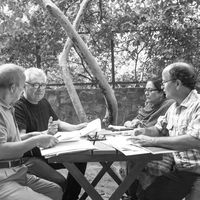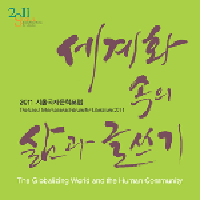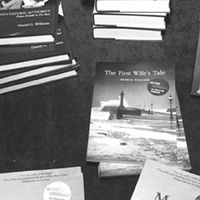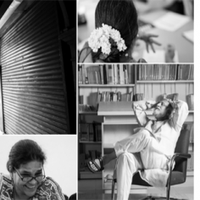Writing transnationally: Poets on writing between places

People’s lives are more mobile than ever with estimates that this will only increase. However, the need for feeling like one belongs in a place is even more relevant in a world of constant change.
Sociologists Anthony Elliott and John Urry examine this increased mobility, investigating how it changes behaviour and transforms everyday lives, and they highlight that despite this mobility attachment to place remains an important aspect of people’s everyday lives. (Elliott and Urry, 2010)

However, rather than attachment to just one place, the more people migrate the more they will develop a series of attachments that overlap and mix. Geographers Katherine Brickell and Ayona Datta claim that people can belong to a number of localities and that these localities overlap in the everyday lives and interactions of a migrant. Writer Taiye Selasi supports this idea, insisting ‘don't ask where I'm from, ask where I'm a local’. Instead of thinking of herself as a writer from Ghana and Nigeria or from England and the USA, she describes how the different cities and suburbs she’s lived in have informed the way she perceives her place in the world.
The more artists and authors migrate and become influenced by the multiple cultures they live in, the more difficult it becomes to define them by their birth nation, such as an “Irish poet” or a “South Korean installation artist”. By describing an artist as such it may ignore the influences they gained while living elsewhere, influences that are most likely present in their creative work. In this increasingly mobilised world it’s important to dig a little deeper into the localities that inform the creative trajectory.
As poet Kim Cheng Boey observes:
Migration is not a simple act of complete uprooting and swapping one home and culture for another, abandoning one’s past life and starting a fresh slate in a new environment…it triggers a continuing process of negotiation, of shuttling back and forth between places, between the past and the present (Boey, Cahill and Aitkin, 2013: 19).
By looking at the way artists and writers explore their overlapping places it is possible to gain an insight into ways in which one can adapt to the challenge of living between places.
Writing experiences of living between cultures
Beyond the genre of travel literature, there are many ways to write between places. One way to write across cultures is to draw inspiration from foreign texts. There is a long history of cross-pollination between cultures through the written word, however it was a trend that gained particular momentum in the 20th century, when there were several authors and artists who were inspired by unfamiliar cultures. This is famously seen in Picasso’s work Les Demoiselles d'Avignon for example, which drew on his encounters with African masks in order to develop an aesthetic which was until then unexplored in European art. Writers of this era also looked to other cultures, with poet Ezra Pound translating poems from Chinese even though he didn’t speak the language and the Beat poets being influenced by the Japanese Haiku form. Drawing from foreign works allowed these artists and writers to break free from established aesthetics to create innovative work. However, drawing from other cultures is a delicate balance between innovation and cultural appropriation, as the Lionel Shriver speech at the 2016 Brisbane Writers Festival and its subsequent debate demonstrated.
Here I would like to focus on examples of poets writing between cultures they have themselves lived in and experienced. Stan Smith (2007) investigated the practice of a number of poets and how they incorporate themes of displacement in Poetry and Displacement. He argues that there are many ways that poets investigate displacement, and that it is not a matter of simply considering external, geopolitical circumstances. Smith gives examples of displacement between present and past, displacement within language and the sense of not belonging anywhere.
Poet John Mateer explores sense of place through the prism of history and movement through time. In an interview with David Shook, Mateer explains:
I don’t think in terms of place, language and culture – rather in terms of history: I see every place, just like every cultural act, and every person, as being an embodiment of History. I see it in almost the Buddhist sense of pratītya-samutpāda – i.e., that conditions produce phenomena – and so for me place is deeply connected with person and history. Something that means that I usually feel quite ‘familiar’ in any place. (Shook, 2013)
Mateer is using history to trace the intangible links that tie routes and influences together. By choosing to follow the Portuguese and the Moorish empires in his books Southern Barbarians (2011) and Unbelievers, or the Moor (2013), Mateer has a framework through which to explore global connections and overlaps. He explores the material space around him as he searches out past resonances. Spaces between places also disappear as he quickly switches between his lived experiences, and by recalling Australia while exploring Singapore, for example, he finds the connections between places.
Displacement between languages is another theme often explored by poets writing between cultures. Writer Merlinda Bobis writes across three languages – English, Pilipino and Bikol – and as one critic observed of her work, ‘Cultures meet, mix, and sometimes collide on the tongue’. Writer Paul Venzo describes this process of self-translation as:
more than just a single author’s capacity to transport words across languages. Rather, the ‘self’ in self-translation suggests a mechanism through which the author / translator enacts a kind of personal cultural and linguistic nomadism, one that reflect the kind of cross-cultural identity. (Venzo, 2016)
It is through the act of switching languages that the writer finds a way of expressing the “in-betweenness” of their experience.
Academic Jahan Ramazani (2009) also explored the role of poetry and transnationalism in the work A Transnational Poetics. A driving force behind Ramazani’s research was the need to reconceptualise twentieth and twenty-first-century poetry studies to take into account the transnational complexities embodied in many poets and their work.
Kim Cheng Boey, who grew up in Singapore and now lives in Australia, is such a poet whose work explores these complexities. He explains that:
Displacement has always been there in my work. The feeling of not-being-at-home. The quarrel with the self and where one is. In a sense, displacement is what makes writing possible and necessary. Moving from one place to another, adopting different positions of seeing and being…you leave home in order to come back to it. (Kon and Boey, 2010)
The process of displacement is an integral part of his life and his creative work. Boey takes this challenging experience and creates work that gives insight into an increasing familiar way of life for many people who now migrate across the globe. These perspectives found in the works of transnational writers are a way of understanding the complexities of living between places.
Poet Omar Musa explores his Australian-Malay hybrid identity through poetry, specifically using ‘poetry as a way to access and understand my Malay side’. In an interview with Peril magazine he explains that ‘Malaysia is a complex and confusing place, where a rich history grapples with modernity. Growing up outside it, it is easy to feel removed and I needed an access point (besides my family and the people I met on visits), which has turned out to be poetry.’ More than just a work of art, creative writing can be a way to interrogate, explore and confront the challenging process of living between cultures.
References:
- BOEY, K. C., CAHILL, M. & AITKIN, A. (eds.) 2013. Asian Australian Poetry, Puncher & Wattmann: Glebe.
- BRICKELL, K. & DATTA, A. (eds.) 2011. Translocal Geographies Space, Places, Connections, Farnham and Burlington: Ashgate.
- ELLIOTT, A. & URRY, J. 2010. Mobile Lives, Routledge: London.
- KON, D. Z and BOEY, K. C.. 2010. ‘A Sense of Questing: Kim Cheng Boey on Poetry’ in Cerise Press, Vol. 1, Issue 3 at http://www.cerisepress.com/01/03/a-sense-of-questing-kim-cheng-boey-on-poetry/view-all
- MUSA, O. 2013. ‘The Amok of Omas Musa (Unfinished)’ in Peril at http://peril.com.au/back-editions/the-amok-of-omar-musa-unfinished/
- RAMAZANI, J. 2015. A Transnational Poetics, University of Chicago Press: Chicago.
- SELASI, T. 2014. ‘Don’t ask where I’m from, ask where I’m a local’, TED talks at https://www.ted.com/talks/taiye_selasi_don_t_ask_where_i_m_from_ask_where_i_m_a_local
- SHOOK, D. 2013. ‘David Shook Interviews John Mateer’ in Cordite at http://cordite.org.au/interviews/john-mateer/
- SMITH, S. 2007. Poetry and Displacement, Liverpool University Press: Liverpool.
- VENZO, P. 2016. ‘(Self)Translation and the Poetry of the ‘In-between’’, in Cordite at http://cordite.org.au/scholarly/selftranslation-in-between/
Claire Rosslyn Wilson is a poet and non-fiction writer who focuses on writing about arts and multicultural themes. She has eight years of professional experience in resource development and the arts and has worked with international and non-profit organisations in Thailand, Singapore and Australia. She has had her work published in various journals and is currently doing a PhD on creative writing and cultural adaptation. You can follow her on Twitter @clairerosslyn.
Similar content
from - to
23 Nov 2012 - 25 Nov 2012
from - to
24 May 2011 - 26 May 2011
posted on
21 Mar 2023
posted on
26 Oct 2012
from - to
25 Nov 2016 - 27 Nov 2016






